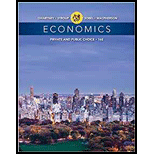
Economics: Private and Public Choice (MindTap Course List)
16th Edition
ISBN: 9781305506725
Author: James D. Gwartney, Richard L. Stroup, Russell S. Sobel, David A. Macpherson
Publisher: Cengage Learning
expand_more
expand_more
format_list_bulleted
Question
Chapter 1, Problem 3CQ
(a):
To determine
Rationing method.
(b):
To determine
Grade rationing and students behavior.
Expert Solution & Answer
Trending nowThis is a popular solution!

Students have asked these similar questions
What are the pros and cons of market economy?
Should grades in an economics class be rationed according to the dollar price instead of how well students do on exams? If they write and prospective employers heard of it, what effect might this have on the value of your college degree?
What type of economists believe that markets naturally self-correct, and will reward good strategies and punish bad ones?
Chapter 1 Solutions
Economics: Private and Public Choice (MindTap Course List)
Knowledge Booster
Similar questions
- Why is "choice" an important concept in Microeconomics?arrow_forwardShould grades in an economics class be 'rationed' according to dollar price instead of how well a student does on exams? If they were and prospective employers learned of it, what effect might this have on the value of your college degree?arrow_forwardThink of an economic decision you made recently wherein the benefit outweighed the cost (or the cost outweighed the benefit).arrow_forward
- How would you choose between a diamond and a bottle of water in the different scenarios described in the video? You MUST explain your answer using economic concepts you have learned in the course so far. What did you or your family do during the severe shortage of toilet paper at the beginning of the pandemic in 2020? How would you value a bag of 12 toilet paper compared to a diamond back then? Would it be different compared to during normal circumstances? Explain your answer.arrow_forwardWhy is economics often described as the science of constrained choice?arrow_forwardDraw graphs to show "People respond to incentives and disincentives" in relation to the demand curve and supply curve for good X.arrow_forward
- Which is a true statement about marginal benefit? It is the difference (or change) in cost of a different choice. To an individual, one good may have a larger marginal benefit than than another. The amount of benefit a person receives from a good or service remains constant.arrow_forwardYou and other college students are deciding whether to major in music or engineering. You learn that there is a shortage of engineers, making it easy for engineering graduates to find employment, while there is a glut of musicians for whom finding a job is difficult. As a result, you and many other college students decide to major in engineering. Which economic principle does this illustrate? a) Markets tend to move towards equilibrium as individuals respond to incentives. b) Government intervention can improve efficiency when there is a market failure. c) Changes in incentives are unlikely to change the decisions people make. d) Individuals do not normally take into account the decisions of other individuals.arrow_forwardWhich of the following would be the least likely thing an economist would study? What new platforms are teens and young adults using to download music and movies? What is the effectiveness of a new $50 million government campaign to keep teens from vaping? What types of movies do children like to watch in the summer? What are the health effects of new energy drinks on young consumers?arrow_forward
- What can a marketer do to positively influence a situation in which a consumer is ready to buy but has not yet done so?arrow_forwardthe graph shows the supply and demand curves for a certain product, which has a current selling price of $300. The laws of supply and demand most support which conclusion about the product?arrow_forwardSuppose you go to a restaurant and buy an expensive meal. Halfway through, despite feeling quite full, you decide to clean your plate. After all, you think, you paid for the meal, so you are going to eat all of it. What’s wrong with this thinking?arrow_forward
arrow_back_ios
SEE MORE QUESTIONS
arrow_forward_ios
Recommended textbooks for you
 Economics (MindTap Course List)EconomicsISBN:9781337617383Author:Roger A. ArnoldPublisher:Cengage Learning
Economics (MindTap Course List)EconomicsISBN:9781337617383Author:Roger A. ArnoldPublisher:Cengage Learning

 Microeconomics: Private and Public Choice (MindTa...EconomicsISBN:9781305506893Author:James D. Gwartney, Richard L. Stroup, Russell S. Sobel, David A. MacphersonPublisher:Cengage Learning
Microeconomics: Private and Public Choice (MindTa...EconomicsISBN:9781305506893Author:James D. Gwartney, Richard L. Stroup, Russell S. Sobel, David A. MacphersonPublisher:Cengage Learning Macroeconomics: Private and Public Choice (MindTa...EconomicsISBN:9781305506756Author:James D. Gwartney, Richard L. Stroup, Russell S. Sobel, David A. MacphersonPublisher:Cengage Learning
Macroeconomics: Private and Public Choice (MindTa...EconomicsISBN:9781305506756Author:James D. Gwartney, Richard L. Stroup, Russell S. Sobel, David A. MacphersonPublisher:Cengage Learning Economics: Private and Public Choice (MindTap Cou...EconomicsISBN:9781305506725Author:James D. Gwartney, Richard L. Stroup, Russell S. Sobel, David A. MacphersonPublisher:Cengage Learning
Economics: Private and Public Choice (MindTap Cou...EconomicsISBN:9781305506725Author:James D. Gwartney, Richard L. Stroup, Russell S. Sobel, David A. MacphersonPublisher:Cengage Learning

Economics (MindTap Course List)
Economics
ISBN:9781337617383
Author:Roger A. Arnold
Publisher:Cengage Learning



Microeconomics: Private and Public Choice (MindTa...
Economics
ISBN:9781305506893
Author:James D. Gwartney, Richard L. Stroup, Russell S. Sobel, David A. Macpherson
Publisher:Cengage Learning

Macroeconomics: Private and Public Choice (MindTa...
Economics
ISBN:9781305506756
Author:James D. Gwartney, Richard L. Stroup, Russell S. Sobel, David A. Macpherson
Publisher:Cengage Learning

Economics: Private and Public Choice (MindTap Cou...
Economics
ISBN:9781305506725
Author:James D. Gwartney, Richard L. Stroup, Russell S. Sobel, David A. Macpherson
Publisher:Cengage Learning